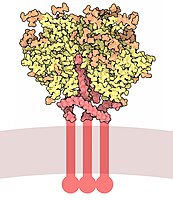
Photo from wikipedia
Structural information on the surface envelope proteins of lentiviruses and related betaretroviruses is critical to understand mechanisms of virus-host interactions. However, experimental determination of these structures has been challenging, and… Click to show full abstract
Structural information on the surface envelope proteins of lentiviruses and related betaretroviruses is critical to understand mechanisms of virus-host interactions. However, experimental determination of these structures has been challenging, and only the structure of the human immunodeficiency virus type 1 gp120 has been determined. ABSTRACT The surface envelope glycoproteins of nonprimate lentiviruses and betaretroviruses share sequence similarity with the inner proximal domain β-sandwich of the human immunodeficiency virus type 1 (HIV-1) gp120 glycoprotein that faces the transmembrane glycoprotein as well as patterns of cysteine and glycosylation site distribution that points to a similar two-domain organization in at least some lentiviruses. Here, high-reliability models of the surface glycoproteins obtained with the AlphaFold algorithm are presented for the gp135 glycoprotein of the small ruminant caprine arthritis-encephalitis (CAEV) and visna lentiviruses and the betaretroviruses Jaagsiekte sheep retrovirus (JSRV), mouse mammary tumor virus (MMTV), and consensus human endogenous retrovirus type K (HERV-K). The models confirm and extend the inner domain structural conservation in these viruses and identify two outer domains with a putative receptor binding site in the CAEV and visna virus gp135. The location of that site is consistent with patterns of sequence conservation and glycosylation site distribution in gp135. In contrast, a single domain is modeled for the JSRV, MMTV, and HERV-K betaretrovirus envelope proteins that is highly conserved structurally in the proximal region and structurally diverse in apical regions likely to interact with cell receptors. The models presented here identify sites in small ruminant lentivirus and betaretrovirus envelope glycoproteins likely to be critical for virus entry and virus neutralization by antibodies and will facilitate their functional and structural characterization. IMPORTANCE Structural information on the surface envelope proteins of lentiviruses and related betaretroviruses is critical to understand mechanisms of virus-host interactions. However, experimental determination of these structures has been challenging, and only the structure of the human immunodeficiency virus type 1 gp120 has been determined. The advent of the AlphaFold artificial intelligence method for structure prediction allows high-quality modeling of the structures of small ruminant lentiviral and betaretroviral surface envelope proteins. The models are consistent with much of the previously described experimental data, show regions likely to interact with receptors, and identify domains that may be involved in mechanisms of antibody neutralization resistance in the small ruminant lentiviruses. The models will allow more precise design of mutants to further determine mechanisms of viral entry and immune evasion in this group of viruses and constructs for structural determination of these surface envelope proteins.
Journal Title: Journal of Virology
Year Published: 2021
Link to full text (if available)
Share on Social Media: Sign Up to like & get
recommendations!